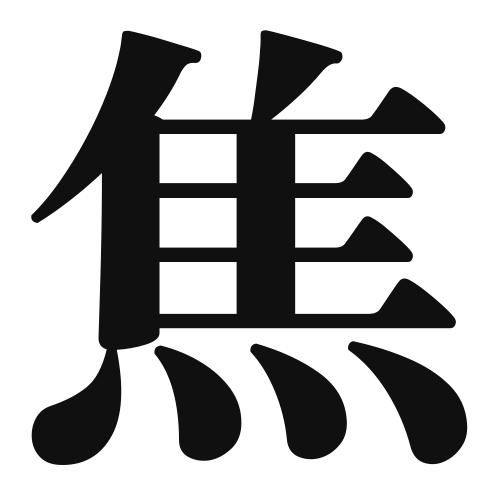1. Overview of Meaning
The kanji “焦” (shō) primarily means “to burn” or “to scorch.” It conveys the idea of something being heated to the point of damage or destruction, often used in contexts related to cooking or emotional states.
2. Formation and Radical
Formation of the Kanji: The kanji “焦” is a phono-semantic compound (形声文字), which means it combines both a phonetic and a semantic component. The left part, “火” (fire), indicates the meaning related to burning, while the right part, “肖,” contributes to the pronunciation.
Radical: The radical of “焦” is “火” (fire), which is commonly associated with heat and burning in various kanji.
3. Examples of Usage
Common Words and Phrases: Some frequently used words that include “焦” are:
- 焦げる (kogeru) – to be burned
- 焦燥 (shōsō) – impatience or anxiety
Example Sentences in Daily Conversation:
- 料理をしているとき、鍋が焦げてしまった。
(While cooking, the pot got burned.) - 彼は焦っているように見えた。
(He seemed to be anxious.)
4. Synonyms and Antonyms
Similar Kanji: A kanji with a similar meaning is “焼” (yaku), which means “to grill” or “to bake.” The difference lies in the intensity of heat; “焦” implies burning or scorching, while “焼” refers to cooking without necessarily damaging the food.
Antonyms: A kanji with an opposite meaning is “冷” (rei), which means “cold.” It represents the absence of heat, contrasting with the burning connotation of “焦.”
5. Cultural and Historical Background
Relation to Japanese Culture: The concept of “焦” is significant in Japanese culture, especially in cooking and traditional practices. It reflects the importance of heat management in culinary arts.
Proverbs and Idioms: One common expression is “焦ると失敗する” (aseru to shippai suru), which translates to “If you rush, you will fail.” This highlights the idea that impatience can lead to mistakes, linking back to the meaning of “焦” as a state of anxiety or burning urgency.
